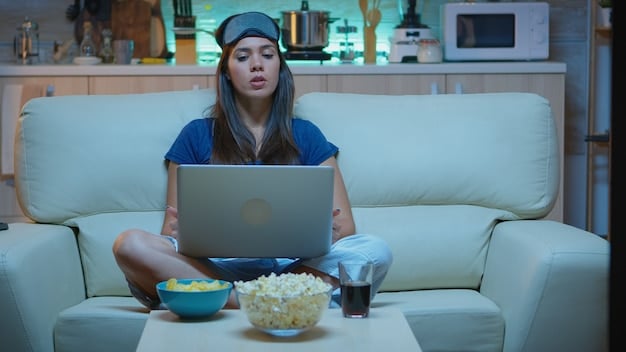Binge-Watching and Productivity: Balance & Boost Life

Binge-watching, while a popular form of entertainment, demands a strategic approach to avoid hindering productivity and daily responsibilities, requiring conscious effort to integrate leisure without sacrificing personal or professional commitments.
In an era teeming with captivating narratives and endless streaming options, **Binge-Watching and Productivity: How to Balance Entertainment and Responsibilities** has emerged as a surprisingly common challenge for many. The allure of one more episode often clashes with pending deadlines, household chores, or even essential self-care routines. Navigating this modern dilemma requires a thoughtful blend of discipline and self-awareness, ensuring that entertainment enriches life rather than detracting from it.
Understanding the Allure of Binge-Watching
The phenomenon of binge-watching, characterized by consuming multiple episodes of a television series in a single sitting, has profoundly reshaped our leisure habits. Its escalating popularity is no mere coincidence; it is deeply rooted in human psychology and the sophisticated design of modern streaming platforms. Understanding why we are drawn to this activity is the first step toward managing its impact on our lives.
One primary driver is the desire for narrative immersion. Unlike traditional weekly broadcasts, streaming services allow viewers to dive headfirst into complex storylines and fully formed worlds without interruption. This unbroken narrative flow deepens engagement, making it difficult to pause the experience once it begins. The cliffhanger ending of almost every episode is a deliberate design choice, crafted to exploit our natural curiosity and compel us to watch “just one more.” This psychological hook, known as the Zeigarnik effect (the tendency to remember uncompleted tasks more than completed ones), plays a significant role in our inability to stop viewing.
The Dopamine Loop and Escapism
Beyond narrative pull, binge-watching triggers a potent biochemical response. When we engage in pleasurable activities, our brains release dopamine, a neurotransmitter associated with reward and motivation. Each new episode, each plot twist, each character development provides a small hit of dopamine, creating a positive feedback loop that encourages continued consumption. This neurochemical reward system can make binge-watching feel incredibly satisfying, even addictive, making it hard to prioritize other less immediately gratifying tasks.
Moreover, streaming offers an unparalleled avenue for escapism. In a world often fraught with stress, deadlines, and responsibilities, immersing oneself in a fictional universe provides a much-needed mental break. It allows individuals to temporarily forget their own worries and live vicariously through characters, offering a form of psychological relief. This escape, while beneficial in moderation, can become problematic if it consistently takes precedence over addressing real-world obligations. The ease of access, combined with personalized recommendations from algorithms, further solidifies binge-watching as a convenient and endlessly available source of comfort and distraction.
The combined effect of narrative appeal, dopamine reinforcement, and accessible escapism creates a powerful, almost irresistible force that draws us into prolonged viewing sessions, often at the expense of other activities. Recognizing these underlying mechanisms is crucial for developing strategies to reintegrate balance into our daily routines and ensure that entertainment remains a source of joy, not a drain on our productivity.
Identifying the Impact on Productivity
While binge-watching offers undeniable pleasure, its unchecked indulgence can cast a long shadow over productivity and dampen our capacity to fulfill daily responsibilities. The subtle erosion of time and energy often goes unnoticed until the cumulative effects become significant, impacting various facets of life from work and academic performance to personal well-being and relationships.
Time Displacement and Task Prioritization
The most immediate and apparent impact of excessive binge-watching is the displacement of time. Hours intended for work, study, exercise, or even sleep are frequently absorbed by streaming content. This phenomenon often begins innocuously, with the intention to watch “just one episode,” which then spirals into several. Consequently, important tasks are either delayed, rushed, or neglected entirely. When responsibilities are postponed, the pressure mounts, leading to increased stress and a diminished quality of work.
This displacement directly affects task prioritization. The immediate gratification of entertainment often wins against the long-term benefits of productive activities. Our brains are wired to prefer instant rewards, making it challenging to choose a difficult but necessary task over effortless entertainment. This habit can cultivate a cycle of procrastination, where the most pressing duties consistently take a backseat, leading to a build-up of unaddressed obligations.

Reduced Energy and Mental Fatigue
Prolonged screen time, especially late into the night, significantly disrupts sleep patterns. Adequate sleep is fundamental for cognitive function, energy levels, and emotional regulation. When sleep is compromised due to binge-watching, individuals often wake up feeling groggy, less alert, and with reduced capacity for complex thought or sustained effort. This mental fatigue directly translates into decreased productivity throughout the day, making it harder to concentrate, retain information, and make sound decisions.
- Cognitive Decline: Excessive screen exposure, particularly passive consumption, can strain cognitive resources, leading to difficulties in focus and problem-solving, even when not actively watching.
- Physical Inactivity: Binge-watching typically involves long periods of sitting, which can contribute to a sedentary lifestyle and a lack of physical activity, further reducing overall energy levels and contributing to sluggishness.
- Social Isolation: While seemingly harmless, excessive solo screen time can replace social interactions, leading to feelings of loneliness and a reduced sense of community, which indirectly impact mental well-being and motivation for productive tasks.
Understanding these impacts is vital. It’s not just about losing time; it’s about the cumulative effect of compromised sleep, mental drain, and misallocated priorities that truly undermines productivity and overall well-being. Recognizing these patterns allows us to proactively seek constructive changes rather than passively falling victim to the cycle.
Strategies for Mindful Binge-Watching
The goal is not to eliminate binge-watching but to integrate it mindfully into your life, transforming it from a potential distraction into a rewarding leisure activity. Achieving this balance requires conscious planning and the implementation of practical strategies that respect both your desire for entertainment and your need for productivity.
Setting Clear Boundaries and Limits
Perhaps the most critical step is establishing explicit rules around your viewing habits. This entails deciding beforehand when you will watch, for how long, and what conditions must be met before pressing play. Treat your viewing time as any other appointment in your schedule—something you commit to fully but also something with definitive start and end points.
- Schedule Your Sessions: Designate specific blocks of time for binge-watching, just as you would for work or exercise. For instance, “I will watch two episodes after dinner, from 7 PM to 9 PM, but only if all my chores are done.”
- Use Timers: Set an alarm for when your viewing session should end. When the timer goes off, pause the episode, even if you’re in the middle of a suspenseful scene. This builds discipline and reinforces the idea that entertainment time is finite.
- Episode Limits: Pre-determine how many episodes you will watch in a single sitting. Commit to this number, whether it’s one, two, or three, and log off once you hit your limit. This prevents the “just one more” trap.
Making these boundaries non-negotiable is key. It creates a framework that allows you to enjoy your shows without guilt or the fear of neglecting responsibilities. Over time, these practices become habits, making mindful viewing second nature.
Creating a Pre-Watching Checklist
Before settling down for a viewing session, create a short checklist of essential tasks that must be completed. This acts as a powerful motivator and ensures that responsibilities are handled before leisure takes over. The satisfaction of checking off these items enhances your enjoyment of the show, as you know you’ve earned your relaxation.
Your checklist could include anything from finishing a work assignment, replying to important emails, completing household chores, or exercising. The act of proactively addressing these tasks eliminates the anxiety that often accompanies procrastination. By front-loading your productivity, you can fully immerse yourself in your chosen series without an underlying current of guilt or looming deadlines. This strategy aligns entertainment with accomplishment, making leisure feel truly earned and free from cognitive burden.
Implementing these strategies shifts binge-watching from a passive, potentially disruptive activity to a deliberate, controlled, and ultimately more enjoyable part of your routine. It empowers you to consume content on your terms, maintaining a healthy equilibrium between your passion for stories and your pursuit of productivity.
Integrating Productivity Techniques
The principles of productivity, often applied to work and study, can be surprisingly effective when adapted to manage entertainment habits. By consciously integrating established techniques, we can transform potentially excessive binge-watching into a more structured and less disruptive activity, turning passive consumption into an active, managed choice.
The Pomodoro Technique Adaptation
The Pomodoro Technique, traditionally used for work, involves breaking down tasks into focused intervals (typically 25 minutes) separated by short breaks. This method can be ingeniously adapted for managing binge-watching. Instead of continuous viewing, apply the concept of focused work “sprints” to your leisure time or to intersperse breaks during longer watching sessions.
- Watch in Intervals: Decide to watch one episode (or a predetermined segment) and then take a mandatory 15-20 minute break. During this break, engage in a low-intensity productive activity, like tidying a room, responding to a few emails, or preparing a healthy snack.
- Batching Tasks: Use the breaks between episodes to batch quick, related tasks. For example, use one break to empty the dishwasher, the next to fold laundry, and another to plan your next day’s priorities. This prevents the accumulation of small chores.
- Set “Episode Pomodoros”: Treat each episode as a “Pomodoro.” After an episode, force yourself to get up, move around, and accomplish something small before starting the next. This prevents the sedentary trap and keeps your body and mind more active.
This adaptation allows you to enjoy your shows while regularly injecting brief bursts of productivity. It breaks the hypnotic spell of continuous viewing, reminding you of your responsibilities and maintaining a sense of control over your time.
Using Checklists and Rewards
Leveraging the power of checklists and a reward system can significantly bolster your ability to balance entertainment and responsibilities. The simple act of ticking off completed tasks provides a sense of accomplishment and visualizes progress, while a well-defined reward system incentivizes proactive behavior.
Before any viewing session, particularly a longer one, create a concise checklist of 3-5 crucial tasks that need to be completed. These could be work-related, household chores, or personal obligations. The rule is simple: no binge-watching until all items on “the list” are checked off. This creates a powerful condition, effectively linking leisure to prior accomplishment.
Furthermore, consider implementing a tiered reward system. For example, completing a specific set of demanding tasks could earn you a longer binge-watching session, or access to your most anticipated series. For less critical tasks, a single episode might be the reward. This gamified approach makes productivity more engaging and frames binge-watching as a privilege earned through disciplined effort, rather than an unchecked indulgence. It empowers you to take control, turning what might feel like a struggle into a structured and rewarding cycle of accomplishment and relaxation.
Leveraging Technology for Balance
In our technologically-driven world, the very tools that facilitate binge-watching can also be repurposed to help manage it. Numerous apps and digital features are designed to enhance productivity and promote mindful screen time. Leveraging these resources can provide invaluable support in maintaining a healthy equilibrium between entertainment and responsibilities.
Screen Time Management Tools
Most modern smartphones, tablets, and even computers come equipped with built-in screen time monitoring and management features. These tools offer detailed insights into your device usage and allow you to set daily limits for specific apps or categories. By understanding where your time is spent, you can make informed decisions about your viewing habits.
- Set App Limits: Use features like Apple’s Screen Time, Android’s Digital Wellbeing, or third-party apps to set daily limits on streaming applications. Once the limit is reached, the app will be locked for the remainder of the day, acting as an enforced boundary.
- Schedule Downtime: Configure your devices to automatically block certain apps or notifications during specific hours, such as work periods, study time, or bedtime. This reduces temptation and helps you maintain focus on non-entertainment tasks.
- App Blockers: Consider dedicated productivity apps that temporarily block access to distracting websites and applications, including streaming services, for a set period. Tools like Freedom, Cold Turkey, or StayFocusd can be highly effective during work or study sessions.
These technological safeguards create an external layer of discipline, preventing impulsive viewing and helping you stick to your self-imposed limits, fostering a more intentional relationship with your devices and content.
Using Productivity Apps for Scheduling and Reminders
Beyond simply blocking distractions, various productivity apps can actively assist in structuring your day to accommodate both tasks and entertainment seamlessly. These tools help in planning, tracking, and reminding you of your commitments, ensuring that important responsibilities are not overlooked in favor of screen time.
Project management apps, like Todoist, Trello, or Asana, are excellent for listing and prioritizing tasks. You can schedule specific “work blocks” and “leisure blocks,” making your commitments visible and actionable. By visually seeing your planned activities, including your entertainment time, you gain a clearer perspective on your schedule and can better stick to it. Setting up recurring tasks for productivity and specific slots for binge-watching within these apps helps to formalize your schedule, turning intentions into concrete plans.
Furthermore, reminder apps can be invaluable. Use them to set alarms for when a viewing session should end or when a critical task needs to begin. A simple notification stating “Time to stop watching and start work on project X” can be a powerful nudge back to responsibility. Some advanced calendar apps allow for time blocking, where you literally allocate specific hours for specific activities, including your entertainment. Integrating your binge-watching into these structured schedules ensures that it’s a deliberate part of your day, not a default activity that consumes all available free time. By embracing these digital tools, you empower yourself to manage entertainment proactively rather than reactively.

The Importance of Self-Care and Breaks
While productivity is often linked to continuous output, true sustainability and long-term effectiveness hinge on incorporating regular self-care and strategic breaks. This balance isn’t just about managing binge-watching; it’s about nurturing your overall well-being, which in turn enhances your capacity for both pleasure and responsibility.
Scheduled Unplugging and Mindful Movement
In an always-on world, deliberately stepping away from screens and engaging in mindful movement is crucial. This “unplugging” isn’t just about reducing screen time; it’s about reconnecting with your physical environment, your body, and your inner thoughts, allowing for mental detoxification and rejuvenation. Scheduled periods of digital detox can significantly improve mental clarity and reduce the mental fatigue associated with prolonged screen exposure.
Mindful movement, whether it’s a brisk walk, stretching, yoga, or any form of physical activity, helps to break the sedentary cycle often associated with binge-watching. Even short bursts of exercise can boost energy levels, improve mood, and release tension. Incorporating these activities into your breaks or after a viewing session can counteract the physical inertia and mental stagnation that can set in from prolonged sitting. Recognizing that self-care is not a luxury but a necessity for sustained productivity is pivotal. It’s about replenishing your mental and physical reserves so you can approach your responsibilities with renewed vigor and focus.
Prioritizing Sleep and Nutrition
The foundation of both productivity and well-being rests on adequate sleep and proper nutrition. These are often the first casualties of excessive binge-watching, yet their disruption has profound and immediate consequences on overall functioning. Prioritizing these fundamental aspects of self-care is non-negotiable for anyone looking to optimize their balance between entertainment and responsibilities.
When binge-watching extends late into the night, it directly sabotages sleep quantity and quality. The blue light emitted from screens can suppress melatonin production, making it harder to fall asleep. Moreover, the stimulating nature of engaging storylines can keep the mind active, preventing restful sleep. Establishing a consistent bedtime routine, ideally one that excludes screens for at least an hour before sleep, is crucial. This allows the brain to wind down and prepare for restorative rest. Sufficient sleep directly translates into improved cognitive function, better decision-making, and enhanced emotional regulation throughout the day, all of which are vital for productivity.
Similarly, nutrition plays a significant role. Mindless snacking often accompanies binge-watching, leading to poor dietary choices that can result in energy crashes and reduced focus. Consciously planning healthy meals and snacks, and avoiding sugary or heavily processed foods, provides your body with the sustained energy it needs to perform both mentally and physically. Eating regular, balanced meals helps maintain stable blood sugar levels, preventing the dips that can lead to fatigue and irritability. By viewing sleep and nutrition as integral components of your productivity strategy, rather than mere afterthoughts, you create a robust physical and mental foundation that supports both your enjoyment of entertainment and your commitment to responsibilities.
Building Sustainable Habits and Long-Term Balance
Achieving a sustainable balance between binge-watching and productivity isn’t a one-time fix; it’s an ongoing process of self-awareness, adaptation, and habit formation. The goal is to cultivate routines that naturally integrate both entertainment and responsibility without constant struggle, leading to long-term well-being and consistent achievement.
Developing Self-Awareness and Reflection
The cornerstone of building sustainable habits is self-awareness. Regularly reflecting on your behaviors and their impact is crucial for identifying patterns, understanding triggers, and recognizing when adjustments are needed. This reflective practice helps you move from reactive binge-watching to intentional viewing.
- Journaling: Keep a simple log of your binge-watching habits and your daily productivity. Note down how much you watched, what tasks you completed (or didn’t), and how you felt afterward. Over time, patterns will emerge, revealing the true cost or benefit of your habits.
- Identify Triggers: Pay attention to what prompts your binge-watching. Is it stress? Boredom? Procrastination? Recognizing these triggers allows you to address the underlying issues rather than just the symptom.
- Review and Adjust: Periodically review your boundaries and strategies. What’s working? What isn’t? Be flexible and willing to adapt your approach as your life circumstances or viewing preferences change.
This ongoing introspection empowers you to take ownership of your choices and refine your approach, making your efforts towards balance more effective and personalized.
Creating a Supportive Environment
Your environment plays a significant role in shaping your habits. By consciously designing your physical and digital surroundings, you can make it easier to stick to your productivity goals and resist the urge to overindulge in entertainment. This involves both removing temptations and adding facilitators for desired behaviors.
Start by minimizing cues for excessive binge-watching. This could mean positioning your television in a less central area, or even opting to turn off your computer or move your remote control out of reach when you need to focus. For digital environments, consider disabling autoplay features on streaming platforms and logging out of accounts after each session, adding a small barrier that requires a conscious decision to re-engage. These small frictions can be surprisingly effective in breaking impulsive viewing habits. Similarly, create an environment that encourages productivity. Designate a specific, clutter-free workspace. Ensure you have all necessary tools readily available, and consider introducing elements that promote focus, such as noise-cancelling headphones or a designated “work playlist.”
Beyond physical space, cultivate a supportive social environment. Communicate your goals to friends and family, and seek their understanding and encouragement. If possible, find an accountability partner who also seeks to balance their entertainment and responsibilities. Together, you can check in on each other, share tips, and celebrate successes. This shared commitment can provide additional motivation and reinforce positive habits. Ultimately, the cumulative effect of these small, deliberate changes across your physical space, digital interactions, and social circle creates a powerful ecosystem that naturally supports both your productive endeavors and your enjoyment of well-deserved entertainment.
| Key Strategy | Brief Description |
|---|---|
| 📺 Set Clear Boundaries | Schedule specific viewing times and use timers. |
| ✅ Pre-Viewing Checklist | Complete essential tasks before starting to watch. |
| ⏱️ Use Tech Tools | Utilize screen time limits and productivity apps. |
| 😴 Prioritize Self-Care | Ensure adequate sleep, nutrition, and breaks. |
Frequently Asked Questions
▼
Binge-watching, especially late at night, exposes you to blue light from screens, which disrupts melatonin production, the hormone regulating sleep. This interference can make it harder to fall asleep, reduce sleep quality, and impact overall energy levels the following day, affecting your productivity significantly.
▼
Practical steps include setting specific time limits for watching sessions, using timers, creating a “pre-watching” checklist of tasks to complete first, disabling autoplay on streaming platforms, and utilizing screen time management apps on your devices to enforce boundaries automatically.
▼
Yes, you can adapt the Pomodoro Technique. Try watching one episode (or 25-minute segment) and then taking a mandatory 10-15 minute break to complete a small task, like stretching or tidying up. This breaks the continuous viewing cycle and injects mini-productivity bursts.
▼
Mindful binge-watching involves deliberate planning and setting boundaries around your viewing habits, ensuring it fits into your schedule without compromising responsibilities. Traditional binge-watching, in contrast, often occurs impulsively, extending beyond initial intentions and potentially disrupting daily routines and sleep.
▼
Self-care, including adequate sleep and nutrition, along with scheduled breaks and physical activity, are crucial. They replenish energy, improve mental clarity, and prevent burnout. Prioritizing these elements ensures you have the physical and mental capacity to enjoy entertainment while effectively tackling your responsibilities.
Conclusion
Achieving equilibrium between the undeniable pleasure of binge-watching and the imperative of daily responsibilities is a modern challenge, but one that is entirely surmountable. It hinges not on the complete abandonment of enjoyable entertainment, but rather on the cultivation of mindful habits, strategic planning, and the intelligent application of self-awareness and technological tools. By understanding the allure of our favorite series, actively identifying their potential impacts, and implementing practical strategies for control, we can transform binge-watching into a true leisure activity that enriches life without detracting from our productivity or well-being. The ultimate goal is to foster a sustainable lifestyle where both exhilarating stories and essential tasks coexist harmoniously, leading to a more balanced, fulfilled, and productive existence.





